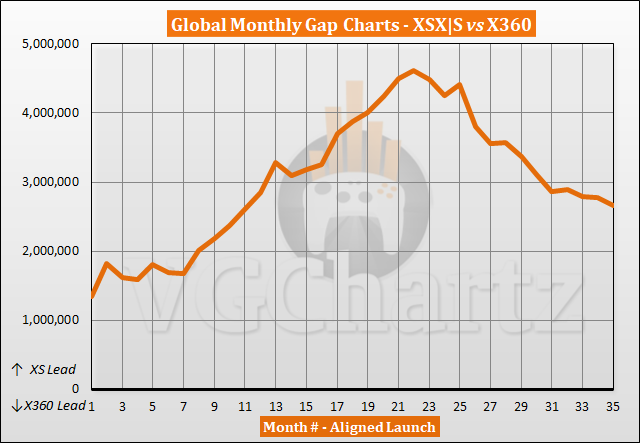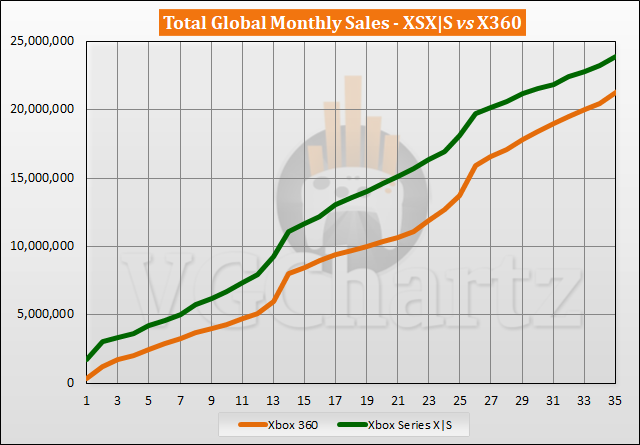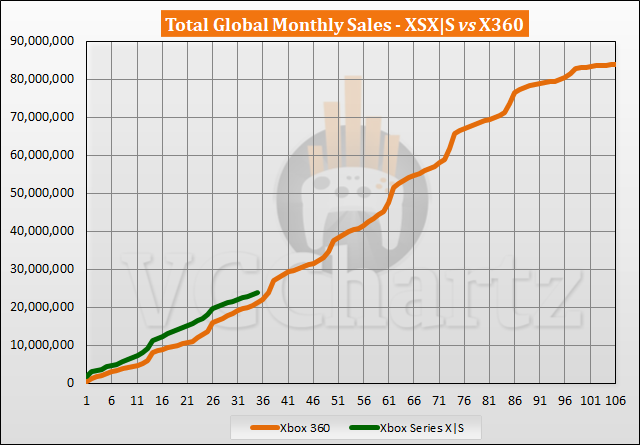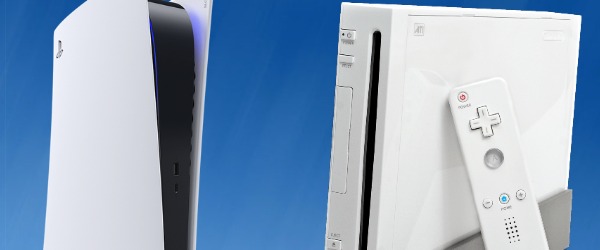
Xbox Series X|S vs Xbox 360 Sales Comparison - September 2023 - Sales
by William D'Angelo , posted on 01 November 2023 / 9,620 ViewsThe VGChartz sales comparison series of articles are updated monthly and each one focuses on a different sales comparison using our estimated video game hardware figures. The charts include comparisons between the PlayStation 5, Xbox Series X|S, and Nintendo Switch, as well as with older platforms. There are articles based on our worldwide estimates, as well as the US, Europe, and Japan.
This monthly series compares the aligned worldwide sales of the Xbox Series X|S and Xbox 360.
The Xbox Series X|S launched in November 2020, while the Xbox 360 launched in November 2005 in North America and December 2005 in Europe and Japan. This does mean the holiday periods for the two consoles do lineup.



XSX|S Vs. X360 Worldwide:
Gap change in latest month: 115,481 - X360
Gap change over last 12 months: 1,818,780 - X360
Total Lead 2,661,422 - XSX|S
Xbox Series X|S Total Sales: 23,902,979
Xbox 360 Total Sales: 21,241,557
September 2023 is the 35th month the Xbox Series X|S has been available for. In the latest month, the gap grew in favor of the Xbox 360 when compared to the aligned launch of the Xbox Series X|S by 115,481 units.
In the last 12 months, the Xbox 360 has caught up to the Xbox Series X|S by 1.82 million units. The Xbox Series X|S is currently ahead by 2.66 million units.
The Xbox Series X|S has sold 23.90 million units in 35 months, while the Xbox 360 sold 21.24 million units. Month 35 for the Xbox Series X|S is September 2023 and for the Xbox 360 is September 2008.
The Xbox 360 did not reach current Xbox Series X|S sales until month 38 when it had sold 27.05 million units.
The Xbox 360 crossed 30 million in month 43, 40 million in month 54, and 50 million in month 62. The Xbox 360 sold 85.73 million units lifetime. The Xbox Series X|S is 61.83 million units behind lifetime Xbox 360 sales.
A life-long and avid gamer, William D'Angelo was first introduced to VGChartz in 2007. After years of supporting the site, he was brought on in 2010 as a junior analyst, working his way up to lead analyst in 2012 and taking over the hardware estimates in 2017. He has expanded his involvement in the gaming community by producing content on his own YouTube channel and Twitch channel. You can contact the author on Twitter @TrunksWD.
More Articles
The cross may even happen before the release of Kinect on X360. Ouch.
the 360 was very consistent in sales over the years
And it won't outsell Xbox 360 with Game Pass around.
I had a lot of hope with the Barbie edition console.
Many people had to replace their 360 at some point due to hardware failure. Although technially 85 million consoles were sold, I wonder if it was really about 60 million users and in reality Xbox has never been the super popular brand it once claimed to be.
Simply no, that's not a thing or a least not in proportion unlike other system. With MS extending warranty to 3 years at the end of 2006 the vast majority of system suffering RROD simply got repaired and those who did bought a 2nd system would simply sell their first system or give them to a friend/family member. In all logic the RROD kept consumer away from Xbox way more so than it did increase the number of unit sold.
It also can be argued that with a standard issue rate of other system but with an equality standard and frankly poor 3 months warranty it might just have lead even more consumer to purchase a second unit yet it does not matter since consumer purchasing 2nd system for any reasons will ever so marginally throw away their old system, in the vast majority of case the old broken system will hit the used market and be eventually repaired.
None in particular and all of them at the same time. They all came with a standard warranty in the range of 3 months to a year. But to assess to impact of hardware failure on the purchase of a second unit that actualy inflate the number of unit sold (meaning the first unit will never be reused) the % of unit that broke while still being covered Is a key factor. A 5% failure rate over 2 years for a system with 1 year coverage vs a 35% failure over 1 year rate for a system with 3 year warranty are very hard to compare and it can be argued both ways.
Anyway the whole concept if the 360 being somehow inflated beyong anything marginal is ludicrous, even more when considering the early on very high attach rate. Looking back at the 360 if the rrod never was a thing it would more than likely had sold way more than it has. All the pieces were in place for the system to reach far and beyong what it had, the rrod and other heat related issue were what did hold back consumers not the other way arround.
I simply can't agree.
From a factual point of view, we know that the failure rate of the OG Xbox 360 was 54%
https://www.ign.com/articles/2009/08/17/report-xbox-360-failure-rate-reaches-54
That's not just a bit above normal numbers, that's territory no other brand of anything even gets close to.
From a personal point of view, not one person I know that had an OG 360 managed to get a working one that lasted beyond a month from the warrenty program. My own personal console went back TWICE, before Microsoft refused to help again.
The closest thing we have to any sort of survey on the matter is the amount of viewers that chimed in, in the comments section of this videogamedunkey video:
https://youtu.be/OeHjN4oWVfk?si=Z5Una6APtsJXdSO5&t=161
How he relays that same exprence I had, and seeming many others in the comment section had. After you sent your Xbox back a few times, Microsoft stopped helping and just tried to sell you on the new model
instead.
There are many places which can repeat this same story:
https://mattbrett.com/blog/i-got-my-rrod-xbox-360-fixed-no-thanks-to-microsoft/
https://www.hanselman.com/blog/the-red-ring-of-death-makes-itself-known (read the comments)
That 54% failure rate is over 360 up to 2012 year which is up to 7 years of use. My 35% was over a 1-year use so both numbers are compatible. Yet this article failed to distribute the failure rate amongst 360 revision which was closer to 100% with original 90nm and 80nm hardware and much more industry-standard starting with 65nm jasper units.
I didn't claim the early failure rate rates were regular either, re-read my post.
I also used MS repair service twice, 1 in 2007 and the other sometime in 2009 just prior to my warranty lapsing which I provoked by wrapping my system in clothes which was common at the time for people whose 360 warranty was about to lapse. each time I got a new console back in less than 48 hours and after that, my 360 did not break again.
Yet this does not matter those are only anecdotal and you are trying to portray the 360 number inflated by the number of people buying a second unit due to RRoD to the heights of up to 25m which is simply ludicrous. and it fails to mention/explain/take into consideration that:
1)People getting a 2nd does not result in an inflated user base in the vast majority of scenarios.
2)People getting second units happens with all hardware, especially with manufacturers producing slim revisions.
3) The very high attach rate of the 360 systems
4) Any actual negative impact of the RROD on 360 sales and public perception.
5) the likeliness of an issue being covered by the warranty on 360 and the actual resulting consumer behavior.
and no 5 is the point I expended upon earlier. if you have a pool of 40m system with issues but 90% are under warranty at the time of occurrence vs a pool of 7m but only 20% under warranty due to an issue requiring more use to appear and less warranty coverage. (and those are not the actual numbers, but just to show that it's debatable). 0.8x7 > 0.1x40
and you find yourself with more people having issues out of warranty on a product that is counterintuitive less prone to issues and so more people that are in the category most susceptible to purchase a new unit. (but it still does not 'inflate' numbers as the vast majority of broken units are kept/sold/given/traded and end up in the use market)






















 Essay Pro
Essay Pro